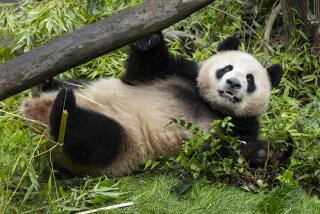Early Bird Lays Hope for Big Condor Brood : Preservation: The earliest egg on record plus more potential breeding pairs raise hopes for a dozen chicks this year.
- Share via
The laying of a California condor egg early in the breeding season, combined with four new pairs of potential condor mates, has San Diego Wild Animal Park officials hoping that as many as a dozen eggs may be hatched in Southern California this year, three times the number in 1989.
The egg was laid in captivity at 1:20 p.m. Monday, taken from the nest several hours later, quickly examined by a zookeeper and placed in an incubator. The examination under intense white light, called “candling,” allowed the keeper to examine both the shell and the interior of the egg.
“The egg looked good,” said Tom Hanscom, spokesman for the park.
The egg will remain in an incubator until Thursday or Friday, when keepers will determine whether or not it is fertile, also through candling. The egg will incubate for about 56 days, and the zoo expects it to hatch near March 12. The chick would then be placed with the captive flock, where it would remain if not transferred to the Los Angeles Zoo.
The same pair of condors produced a female chick named Towasinah last year, so breeders at the Wild Animal Park are confident that this egg is fertile, Hanscom said.
The egg is the earliest breeding of a California condor since record-keeping began in the mid-1800s, and it comes five weeks earlier in the year than the first egg of 1989, he said.
Four new pairs of California condors have reached maturity this year, bringing the total of potential breeding pairs to 11, and park officials hope that as many as 12 healthy chicks in Los Angeles and San Diego will be hatched this year, contrasted with four last year.
Five of the potential breeding pairs are in San Diego, six in Los Angeles. A total of 32 California condors exist, all in captivity and equally divided between the two zoos.
Park officials said they have no explanation for the early laying this year.
“In all likelihood, such early breedings have occurred in the past and they just haven’t been recorded,” Hanscom said. The earliest recorded breeding occurred in early February, 1907.
The early start, however, does not necessarily assure a longer season, Hanscom said, adding, “For all we know, it may end early as well.”
Lloyd Kiff of the Western Foundation of Vertebrate Zoology in Los Angeles said it is possible that weather is the predominant factor in determining the length of the breeding season, citing a condor pair that lost interest in mating last year when a heat wave set in.
Kiff said the condor that laid this egg, AC 8, is particularly active at mating.
“This is a particularly good female. She really cranks out the eggs,” Kiff said. “She’s a lover.”
The animal park hopes the early mating season will translate into two, possibly three eggs from AC 8 and AC 5. (AC stands for adult condor .)
The new egg is the latest in a breeding program that hopes to reintroduce the condor to the wild by 1992, Hanscom said.
More to Read
Sign up for Essential California
The most important California stories and recommendations in your inbox every morning.
You may occasionally receive promotional content from the Los Angeles Times.










